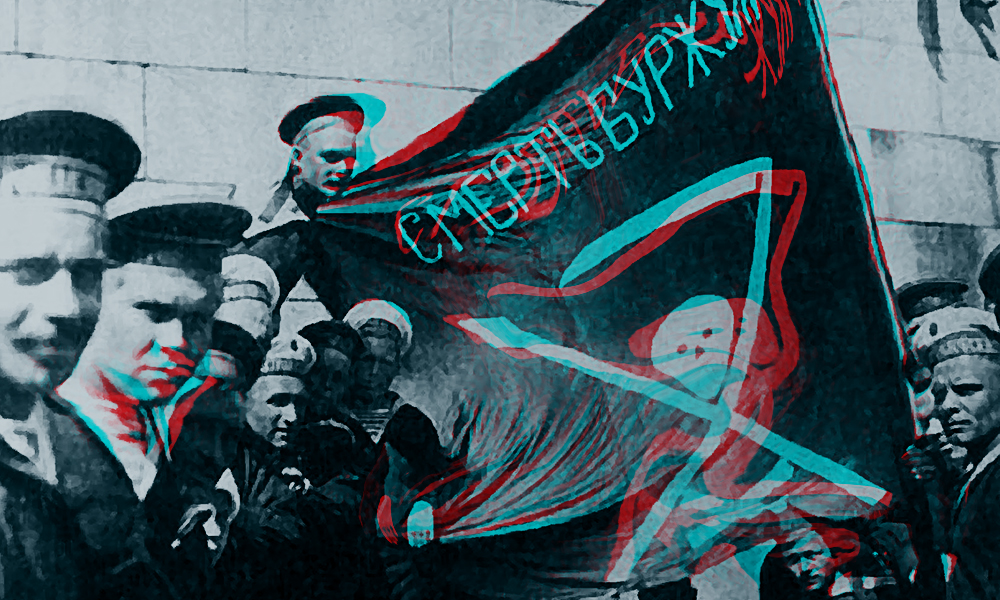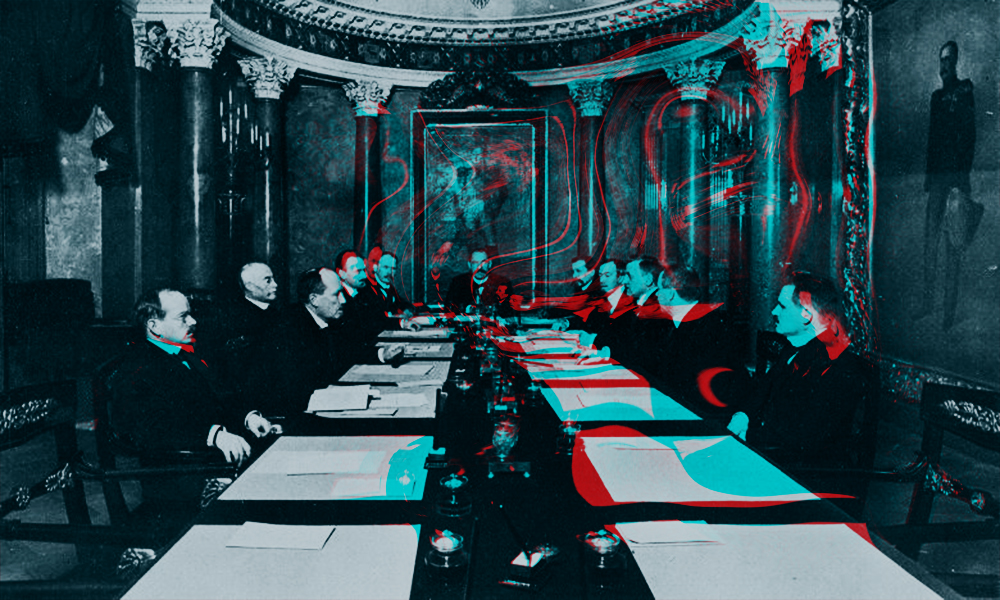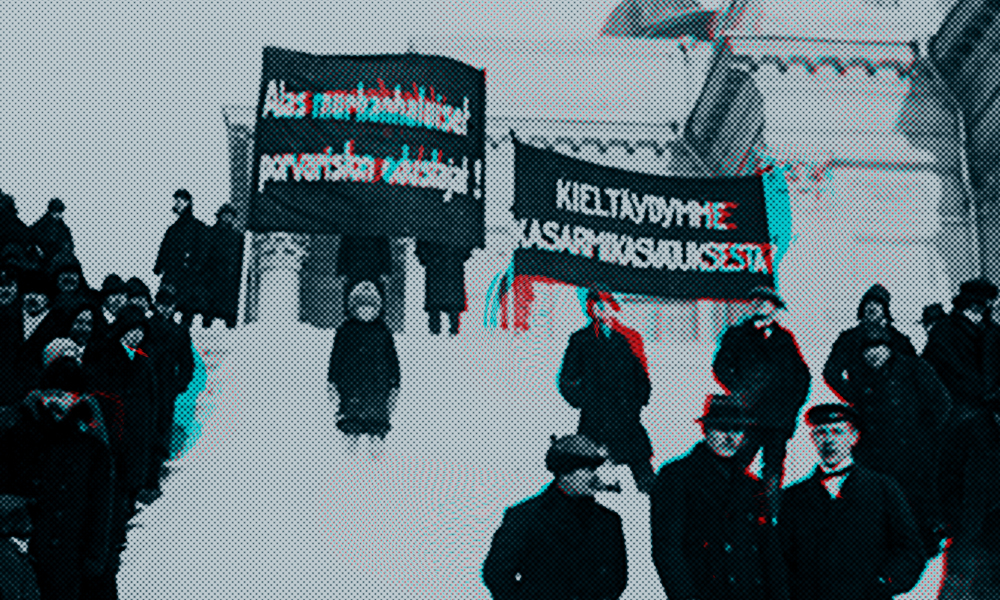Part I | Part II | Part III
The first socialist country in the world? Everyone should know that. But the second? It was the “small and gutsy Finland” (Väinö Linna), land of lumberjacks and mobile phone designers, and I did not know that either until I started writing this article. The term “Finnish revolution” will make most people think of some technical innovation from Nokia. But Finland had its own Red Army!
100 years ago, in January of 1918, the Finnish workers took power into their hands to fight for independence for their country and justice for its inhabitants. The bourgeoisie struck back with force – whether Finnish, Swedish, Russian or German, they all stood together against the Finnish workers – and murdered at least 20,000 Reds.
Even if today’s Finland seems to be a model of social calm, traces of this past can still be found. Most Finns, apart from the few communists, are reluctant to talk about it. Internationally, the Finnish revolution is hardly known among the left. What can we as revolutionaries learn from it today?
Recently, Eric Blanc has argued that Finland’s revolution is a successful example of the “democratic road to socialism” and the strategy of Karl Kautsky. As the three articles in this series will show, even though the Finnish Social Democrats very much desired a parliamentary road, they were forced to carry out an insurrection. Yet since their party had been built up just to participate in elections, their leadership of the insurrection was terrible and led to a bloody defeat.
The Finnish revolution might have enjoyed the best conditions for a successful socialist revolution in the history of capitalism: the working class was able to take power virtually without resistance. Yet the social democratic leaders were able to snatch defeat from the jaws of victory. Far from a vindication, the example of Finland shows the catastrophic results of Kautsky’s strategy. But we will return to this question at the end of the third article.
This text was originally published in German as a pamphlet in early 2009. It has been translated by the author.
Finland before the war
After over 600 years of Swedish rule, Finland became a Grand Duchy of the Russian Empire in 1809. Finland enjoyed a large degree of autonomy, with its own administration, official language, currency, etc. It remained calm during the century of Russian rule. Only in 1899 did Tsar Nicholas II begin a policy of Russification. In response, half a million Finns (out of a total population of three and a half million) signed a petition to the Tsar for the restoration of autonomy.
In the 19th century, sectors of the Finnish bourgeoisie created a nationalist movement. The linguist and historian Adolf Ivar Arvidsson gave the battle cry: “We are not Swedes, nor do we want to become Russians, so let us be Finns.” A Finnish literature developed, mostly by Swedish-speaking members of the elite who learned the language of the lower classes and “finnified” their names. They fought for the Finnish language in education and administration. By 1900, the Finns had established Finnish as an official language on equal footing with Swedish, but also as the language of the emerging nation.
With the Russian Revolution of 1905, political unrest arrived – belatedly – in the Grand Duchy. With the “Red Declaration” from the city of Tampere, the workers’ movement called a general strike. The constitutionalist bourgeois forces joined the strike because they also demanded the restoration of autonomy, even though both camps had separate strike committees. As the Tsar proclaimed his willingness to accept a new constitution for Finland, the bourgeois parties and the leadership of the Social Democratic Party were ready to end the strike. Only a small, radical sector of the workers’ movement wanted to continue the struggle. After the general strike, the Tsar established a parliamentary assembly (eduskunta) for Finland, elected by all Finnish citizens over 24, with certain property qualifications such as a freedom from debt. Since women were also allowed to vote after 1906, Finland is considered by some to be the first country in the world with women’s suffrage – although it was not a sovereign country. The parliament elected a Finnish government, the senate (senaatti), which was under the authority of the Tsar and his governor for Finland.
Finnish industry developed from the 1870s onwards: first wood and paper processing, then a metal industry. In 1914, the Finnish industrial working class was estimated at 110,000 people, although the vast majority of the Finnish population still lived in rural areas. The First World War hit the Finnish economy hard: exports to Great Britain, the main buyer of wood and paper products, were no longer possible – half of the 34,000 workers in this sector were fired. Overall, one third of the working class became unemployed. In addition, around 40,000 young rural workers were employed in the construction of fortifications starting in 1916. When the Russian Revolution began in March 1917, they were thrown out onto the streets. Furthermore, the grain supply was no longer secure, and hunger spread in the cities and in the countryside.
Most of Finland’s ruling class favored autonomy under Russian rule. But a radical wing of the bourgeoisie, particularly among students and the military, demanded immediate separation from Russia – they saw Germany as the future protector of Finnish independence. These activists organized a voluntary battalion of Finns who joined the German army as Jäger (light infantry). They were trained for a possible German intervention in Finland. Part of this unit was deployed on Germany’s Eastern Front, but in 1917, these forces were gradually sent back to Finland. These roughly 2,000 Jäger (jääkärit) went on to play an important role in Finland’s civil war – with all but three of them on the side of the counterrevolutionary whites.
The Finnish workers’ movement
The Social Democratic Party of Finland (Suomen Sosialidemokraattinen Puolue, SDP) was founded in July 1899 as the Workers’ Party of Finland, after Marxist intellectuals won control of the workers’ movement. Especially after the great class struggles of 1906, the party subscribed to a dogma of “class war”: under no circumstances were workers to mingle with the bourgeoisie, neither in parliament nor in sports clubs. This doctrine was recognized by all social democratic parties at the time, but few carried it out as consistently as the Finns – SDP members were not allowed to hold public office, and the newspaper The Worker (Työmies), under the control of radicals since its founding in 1895, even advised its readers to avoid the “bourgeois” cinema! Finland’s national author Väino Linna had his main character, the tenant farmer Akseli Koskela, put it this way:
They always talk about their own affairs as Finland’s affairs: (…) Our national prosperity cannot permit the reduction of hours. No matter what they want, it’s always to the country’s advantage, to the people’s advantage, it’s our society. Well, they’re right about that. This is their society and their Finland. When a socialist representative can’t speak book language, they squawk and mock him in their newspapers. Sometimes I can hardly breathe I hate them so much. (…) Sometimes I even think it would be easy to kill them.
The isolation of the workers’ movement from bourgeois society was a result of the miserable material and legal conditions that Finnish workers were subjected to. The labor laws did not recognize the right to organize or to collective bargaining agreements. In local elections, the weight of a vote was determined by how much a voter paid in taxes. The fact that the aristocracy (and thus also many capitalists, managers, academics, etc.) was largely Swedish-speaking, while the vast majority of workers spoke Finnish, highlighted the disparity between the proletariat and the bourgeoisie. Many Finns emigrated to the USA where they participated in the radical workers movement, such as the Industrial Workers of the World, and some brought these ideas home. Finnish migrants were such an important part of the US workers’ movement that in the early 1920s, up to a third of members of the Communist Party of the US were Finns (and one third of Finns in the US were communists).
In 1907, the Finnish Trade Union Federation (Suomen Ammattijärjestö, SAJ) was founded. The SAJ was much more directly involved in struggles with the class enemy than the SDP, and thus was more radical.
During the general strike of 1905, the SDP formed a Red Guard (punakaarti) to protect the workers’ movement. But this formation showed a tendency towards militancy outside of the control of the party leadership. In the summer of 1906, for example, the Red Guard wanted to support a mutiny by Russian soldiers with a general strike and expand it to an insurrection, which only made the party leadership nervous. At its 1906 congress, the SDP officially dissolved the Red Guard and renounced violence.
The First World War drew the SDP closer to the left wing of the Russian Social Democratic Labour Party (i.e. the Bolsheviks). This was not a question of programmatic affinity – in fact the SDP was proud to unite its “Bolsheviks and Mensheviks” in one party – but rather a result of the Bolsheviks’ unconditional defense of the Finns’ right to self-determination. While other Russian social democrats argued that the relationship between Finland and Russia could only be settled by negotiations between the Finnish parliament and the Russian constituent assembly, V.I. Lenin countered that negotiations could not take place on an equal footing until Finland’s right to self-determination had been recognized:
Finland was annexed by the Russian tsars as the result of a deal with the suppressor of the French revolution, Napoleon, etc. If we are really against annexations, we should say: give Finland the right of secession! Not until this has been said and accomplished can an “agreement” with Finland be a really free and voluntary agreement, a real agreement, and not just a fake. Agreement is possible only between equals. If the agreement is to be a real agreement, and not a verbal screen for subjection, both parties to it must enjoy real equality of status, that is to say, both Russia and Finland must have the right to disagree. That is as clear as daylight.
An international socialist conference had taken place in September 1915 in the Swiss village of Zimmerwald to rebuild the Socialist International, which had broken up at the beginning of the war, with most socialists supporting “their” bourgeoisie. The parties that signed the Zimmerwald Manifesto, drafted by Leon Trotsky, called for international protests against the war and became known as the Zimmerwald movement. At the insistence of the Bolsheviks, the SDP joined Zimmerwald in June 1917. But this was because the SDP leadership wanted to belong to some international structure – they did not think much of the perspective of mobilizing the working class against the imperialist war.
The rhetoric of “class war” made the party seem more radical than it was. Kuusinen advocated joining the Zimmerwald movement even though he did not agree with its revolutionary politics:
I for my part am on a fairly revisionist footing now (…) But it does no harm if outward appearance is more radical than reality. We have always been like that in our party (…) We had made such a dogma of class war (…) If there had been someone who had dared to speak against it, it would have been condemned by the party. But of course we have ventured in practice to act against it.
In an agrarian country like Finland, the peasants played an enormous role. Finnish peasants had enjoyed legal freedom since the 18th century, but many were trapped in conditions similar to serfdom by tenants’ agreements; for example, they had to work a certain number of days on the landowner’s farm. In 1912, about 150,000 farms were run by tenants (toppari). The SDP supported a number of reforms for the tenants (a ban on evictions, for example) and won a surprisingly number of votes in the countryside. In addition to the tenants, there were over 300,000 destitute agricultural workers, the agrarian proletariat, but they were not receptive to political agitation until the beginning of the revolution. With this support from the countryside, the SDP went from strength to strength at elections. In 1907, the party won 80 seats out of 200, and in 1913, it was 90 seats. In 1916, they won an absolute majority with 103 seats (based on 47% of the votes).
The revolution in Russia…
The revolution that broke out in March 1917 in Russia toppled a dynasty that had been in power for five centuries. The Tsar was replaced by a provisional government (first headed by the liberal Prince Lvov, then after July by the Social Revolutionary Alexander Kerensky). The new government promised some democratic reforms, but also vowed to continue the imperialist war at all costs. The reforms had a very limited character, as a new political system was to wait for the Constituent Assembly – which was postponed again and again. There was no recognition of the Finn’s right to self-determination, nor for other oppressed nations in the Tsarist empire. The provisional government offered negotiations and small improvements, but wanted to delay a real solution until the Constituent Assembly, which never took place. In the case of Finland, the Grand Duchy which had been held by the Tsar was transferred to the new government.
Part of Finnish society, namely the social democrats and the “activist,” anti-Russian wing of the bourgeoisie, saw the chaos in Russia as an opportunity to finally gain independence. The SDP was dissatisfied by the provisional government’s hesitation, and instead directed itself to the First All-Russian Congress of Workers and Soldiers’ Councils held in Petrograd in the summer. This Soviet Congress passed a resolution recognizing Finland’s right to independence. But the Menshevik Raphael Abramovitch, tasked with formulating the final version, inserted a clause delegating the final decision to the Constituent Assembly – basically the same position as that of the provisional government.
The SDP leadership “overlooked” this clause in the resolution: in their eyes, the Russian Socialists had just declared their support for Finland’s immediate independence. During the “July Days,” when for a short time it appeared as though the Kerensky government had been overthrown, the SDP used its majority in the eduskunta to pass the Law on Power (valtalaki), which transferred full sovereignty to the Finnish parliament except on questions of foreign policy and war, which were left in the hands the Russian government. The rule of the Tsar or of any Russian regent was declared null and void, with final relations with Russia to be clarified later. This was completely unacceptable to the Kerensky government, which still wanted to defend Russia’s imperialist interests behind a socialist mask. As regent over Finland, Kerensky’s government dissolved the parliament and called new elections for October. The SDP did not want to accept this decision, but with the de facto declaration of independence, the party had gained so much support, and they did not want to risk any new conflicts that might endanger the next electoral victory.

…and its effects in Finland
When the revolution broke out in Russia, state authority in Finland collapsed. The parliament of 1916 with its 103 social democratic deputies was convened for the first time in March 1917. It elected a new senate with Oskari Tokoi, a long-time social democratic member of parliament and the chairman of the SAJ, as head of government (“the first democratically elected socialist prime minister in the world,” according to Fred Singleton). But there was still a Russian governor, no longer appointed by the Tsar but instead by Russia’s new provisional government. This led to endless constitutional wrangling: Had the provisional government assumed the Tsar’s authority? If the Tsar had abdicated without a successor, then sovereignty would have returned to the Finnish parliament. Therefore, Russia’s provisional government declared itself a regent of the Tsar.
Over the course of 1917, independent workers’ protests spread throughout the country. In Turku, for example, there was a general strike in support of a strike by the firemen. The old bourgeois city council rejected a pay raise, so strikers locked some council members in the town hall until they changed their mind. When these council members argued that they lacked a quorum to make a decision, the strike committee sent an armed unit through the city to round up more council members. Even so, the city council still refused to concede, and the workers wanted to remove it from power entirely. Only an intervention by the social democratic prime minister Tokoi was able to force a compromise. He believed that a new law about communal elections needed to be passed in parliament before the old city councils could be removed.
The police almost completely disappeared and were replaced by citizens’ militias – these were paid by the municipal administrations but acted autonomously. The militias in the big cities mostly consisted of workers, so they could hardly be used to repress strikes and demonstrations. For this reason, the bourgeoisie began to found its own Home Guard (suojeluskunta) made up of students and peasants. The old Red Guard was re-founded as well; unlike the militias, it had an explicitly socialist character and was only under the authority of the SDP. At first, the party only wanted to allow a (much less militant-sounding) workers’ defense guard (työväen järjestyskaarti) due to bad memories of the uncontrollable Red Guard from 11 years earlier. Only in October 1917 did the party officially condone the formation of the Red Guard.
It is often claimed that the Red Guard in Finland consisted of “anarchists and hooligans,” i.e. of criminal and declassed elements. But in reality, the exact opposite was the case: great importance was attached to ensuring that only politically reliable party and trade union members with long experience in the workers’ movement were selected. Most Red Guardsmen were somewhat older workers with families; only when the civil war began did thousands of younger workers and unemployed people join en masse. The Red Guard was a paramilitary formation but had almost no weapons. In Tampere, they were able to purchase rifles from the Russian garrison, but this remained the exception.
When new elections were held in October 1917, Social Democracy, to its great surprise, lost its absolute majority. The SDP received 45% of votes and only 92 seats. The party leadership did not recognize these elections, since they considered the previous dissolution of parliament by Kerensky to have been a violation of the Law on Power. The new parliament elected a senate under the conservative Peer Evind Svinhufvud (whose last name means “pig’s head” in Swedish – nomen es omen). The SDP insisted on a retroactive recognition of the Law on Power – i.e. it called on the government to deny its own legitimacy. Neither side could compromise on this question, forcing the SDP to turn away from its preferred strategy, parliamentarism.

The position of the social democracy
In a newspaper, the social democrats criticized the bourgeoisie for its obstinance: workers would be “forced to consider taking power into our hands throughout the country.” Of course, it can be legitimate for a revolutionary leadership to use defensive formulations and define the seizure of power as an act of self-defense – this was a tactic employed by Trotsky in the October uprising to win over wavering sections of the working class. But for the SDP, the seizure of power was not even a “last resort” – it was no more than an empty threat to force the bourgeoisie to make concessions. Oskari Tokoi told the bourgeois majority in the new parliament to adopt the social democratic reform program in order to avoid “the nightmare of revolution.” For the party leadership, revolution was in fact a nightmare. Although they had to sanction increasingly radical actions (from the general strike in November 1917 to the seizure of power two months later), these were never part of a consistent strategy – they were hesitant steps taken only because the party would otherwise lose its control over the radicalizing masses of workers.
Officially, the SDP was in favor of social revolution. This has been part of the party’s program since 1899, which was strongly based on the German Social Democracy’s Erfurt program. In practice, the party was guided by determinism: in the leaders’ view, an underdeveloped country like Finland could only hope for a bourgeois revolution that would eliminate the remnants of feudalism and create a capitalist republic. A socialist revolution, according to this thinking, could only be an “anarchist adventure.” Even if the party saw itself forced to take state power, this would be just a brief episode until a constituent assembly could create a bourgeois constitution. Had there been a socialist majority in such an assembly, then the socialists would have had to limit themselves to passing certain reforms in the interests of the workers. For the SDP, socialism was a question that could only be solved in the developed capitalist countries of Europe – not in Finland, which was universally seen as “unripe” for socialism. The SDP was strongly influenced by Karl Kautsky, the theoretician of the “center” of German Social Democracy. SDP leaders took part in international socialist conferences – Otto Wille Kuusinen, for example, was at the Berne conference in 1912 – but hardly participated in international debates. They were not even well-informed about the conflicts inside Russian Social Democracy, even though they were formally within the same state.
Kullervo Manner, who in 1917–18 was briefly head of the workers’ party and the red government, reported that over the summer, the party was losing its ability to hold back the workers’ actions: “If we are mistaken about the rapid approach of revolution, I would be delighted.” For many in the party, the revolution was not a perspective to which they tried to win the working class – it was a specter they painted on the wall to scare the bourgeois government. Kuusinen warned the capitalists about what would happen if “we, who want to calm the workers down, do not get some kind of concrete results from parliament now.” On November 1, 1917, the SAJ issued an ultimatum to the government to solve the most pressing problems of the working class – but when the ultimatum lapsed, it became clear that the leadership had not prepared any measures at all. When the SAJ congress took place on November 12, and the pot was boiling over. One delegate after the other demanded the immediate seize of power by the SDP. The leadership had to do something to keep control of the situation.
In one week, Nathaniel Flakin will write about the insurrection and the beginning of the civil war.











